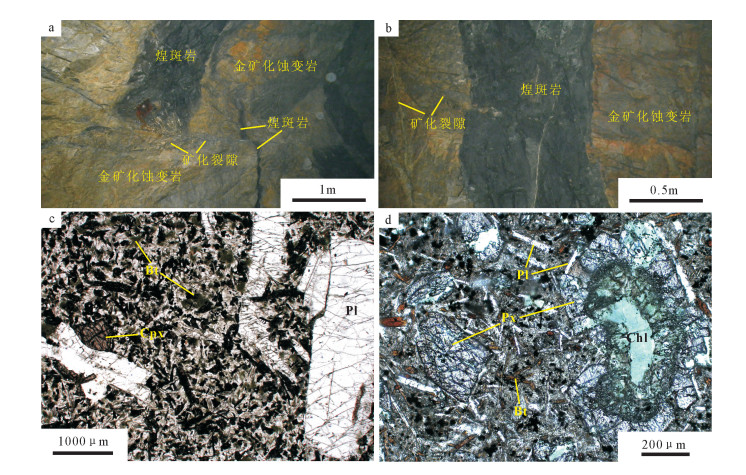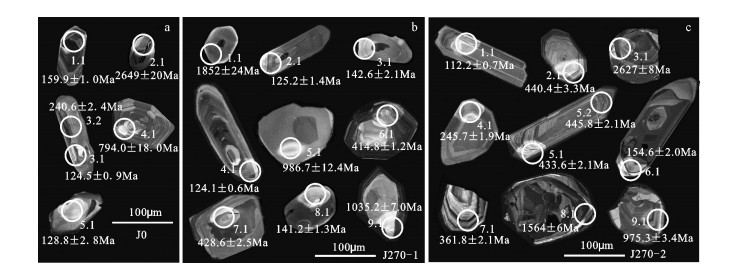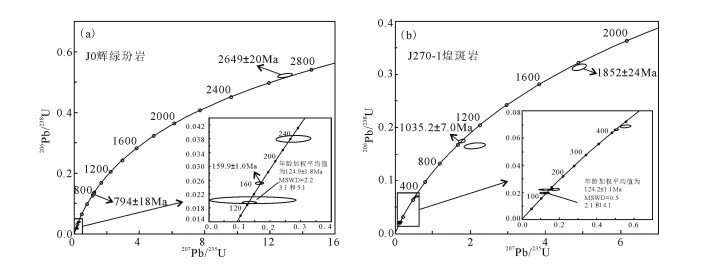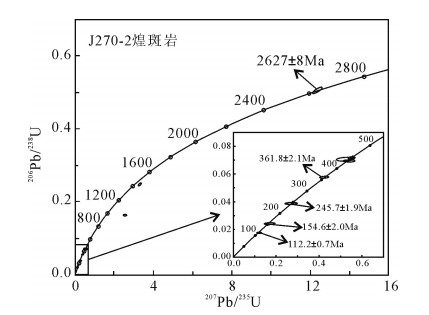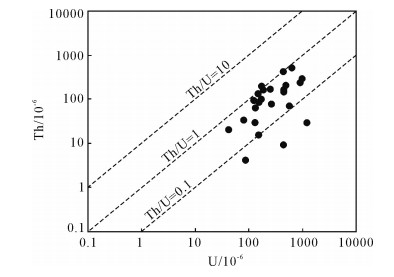Metallogenic epoch and regional crust evolution in the Jiaodong gold deposit, Shandong Province: Evidence from SHRIMP zircon U-Pb ages of mafic dykes
-
摘要:
关于胶东金矿的成矿时代前人已进行了较多研究,但其成矿时限尚没有准确确定。对胶东焦家金矿床成矿前和成矿后的2个基性脉岩进行了锆石SHRIMP年龄测定和锆石氧同位素分析。锆石阴极发光图像显示,样品中有少量岩浆新生锆石,其晶形、环带清晰。在2个成矿前脉岩样品中测得岩浆锆石206Pb/238U年龄最小值为124.9±1.8Ma和124.2±1.1Ma,1个成矿后脉岩样品中测得最小年龄值为112.2±0.7Ma。故成矿前脉岩的侵位年龄小于等于124.9Ma和小于等于124.2Ma,成矿后脉岩的侵位年龄小于等于112.2Ma,金矿的成矿年龄被限制在124~112Ma之间。此外,较多的锆石年龄数据记录了早侏罗世、三叠纪、古生代、新元古代、中元古代和新太古代的岩浆事件和变质事件,指示胶北隆起深部既有华北克拉通新太古代、中元古代和新元古代的地质体或地质事件,也有苏鲁造山带古生代和三叠纪的地质体或地质事件,苏鲁超高压变质带曾俯冲到胶北隆起之下。锆石氧同位素组成变化范围较大,δ18O值为3.86‰~11.37‰,指示了不同时代锆石氧同位素组成的不均一性和物质来源的差异性。
Abstract:Although mineralogenetic epoch of the Jiaodong gold deposit in Shandong Province has been studied by many previous researchers, the accurate time frame of mineralization remains undecided. This paper reports SHRIMP zircon ages and oxygen isotopic values for pre-metallogenic and post-metallogenic mafic dykes in the Jiaojia gold deposit of Jiaodong Peninsula. In CL photos, the igneous zircons show good crystal form and clear zoning. Two samples from pre-metallogenic mafic dykes have recorded concordant ages of 124.9±1.8Ma (n=2, MSWD=2.2)and 124.2±1.1Ma (n=2, MSWD=0.50). A sample from post-mineralization lamprophyre yielded a concordant age of 112.2±0.7Ma (n=1), and therefore the emplacement age of the pre-metallogenetic mafic dykes is ≤ 124.9Ma and ≤ 124.2Ma. The emplacement age of the post-mineralization lamprophyre is ≤ 112.2Ma. The metallogenic age of the Jiaojia gold deposit is ≤ 124.2Ma. These data indicate that time limitation of mineralization of the Jiaojia gold deposit should be from 124Ma to 112Ma. Besides, the obtained multiple stages of inherited zircon ages from the samples have recorded the magmatic and/or metamorphic events of Jurassic, Triassic, Paleozoic, Neoproterozoic, Mesoproterozoic and Neoarchean. This suggests that, in addition to Neoarchean, Mesoproterozoic and Neoproterozoic geological bodies in North China Craton, there are also Paleozoic and Triassic geological bodies from Sulu orogenic belt in the depth of the Jiaobei uplift. These data suggest that the materials of the Sulu ultrahigh-pressure metamorphic belt was thrusting under the Jiaobei uplift. The δ18O values of zircons vary from 3.86‰ to 11.37‰, and this indicates that different stages of zircons have diverse oxygen isotope compositions and diversified material sources.
-
致谢: 野外工作得到山东黄金集团有限公司相关工作人员的帮助和支持,北京离子探针中心宋彪研究员辅导了SHRIMP测试并处理了原始数据,审稿专家提出了宝贵的意见建议,研究工作中山东地质科学研究院张志敏老师、杨德平及刘鹏瑞研究员给予启发和指导,同时得到领导和有关同事的关心,在此一并致以诚挚的感谢。
-
图 1 焦家金矿床区域地质略图(据参考文献[37]修改)
Figure 1. Geological map of the Jiaojia gold deposit
图 2 焦家金矿床煌斑岩和辉绿玢岩野外露头(a、b)和显微(c、d)照片
a—煌斑岩脉被矿脉错断,为成矿前脉岩(J270-1采样位置);b—煌斑岩脉切割矿化破碎带,为成矿后脉岩(J270-2采样位置);c—辉绿玢岩微观特征:斑状结构,基质辉绿结构(单偏光);d—煌斑岩微观特征:煌斑结构,辉石发生绿泥石化(单偏光);Bt—黑云母;Cpx—辉石;Chl—绿泥石;Pl—斜长石
Figure 2. Macroscopic (a, b) and microcosmic (c, d) photographs of lamprophyre and sillite in the Jiaojia gold deposit
表 1 焦家金矿床基性脉岩SHRIMP锆石U-Th-Pb定年结果
Table 1 Zircon U-Th-Pb data measured by SHRIMP for mafic dykes in the Jiaojia gold deposit
样品点 206Pbc/% 元素含量/10-6 同位素比值 年龄/Ma 误差相关系数 206Pb* Th U 232Th/238U 207Pb/206Pb 1σ 207Pb/235U 1σ 206Pb/238U 1σ 207Pb/206Pb 1σ 206Pb/238U 1σ J0 1.1 0.35 9.90 9 457 0.02 0.0479 0.0016 0.166 0.006 0.02511 0.00016 92 79 159.9 1.0 0.183 2.1 0.02 269.0 68 599 0.12 0.1796 0.0022 12.930 0.170 0.52230 0.00290 2, 649 20 2709.0 12.0 0.416 3.1 1.07 7.87 146 465 0.32 0.0493 0.0035 0.133 0.010 0.01950 0.00015 164 170 124.5 0.9 0.104 3.2 0.87 5.84 97 177 0.57 0.0528 0.0045 0.277 0.024 0.03803 0.00038 319 190 240.6 2.4 0.118 4.1 0.14 17.30 130 153 0.87 0.0661 0.0010 1.195 0.034 0.13110 0.00310 809 32 794.0 18.0 0.838 5.1 10.45 3.47 189 179 1.09 0.050 0.0220 0.139 0.062 0.02019 0.00044 180 1000 128.8 2.8 0.048 J270-1 1.1 0.41 36.40 62 135 0.48 0.1133 0.013 4.89 0.015 0.3133 0.008 1852 24 1757.1 12.2 0.516 2.1 0.57 2.70 15 158 0.10 0.0448 0.091 0.12 0.092 0.0196 0.012 -67 222 125.2 1.4 0.127 3.1 0.00 1.60 33 82 0.41 0.0567 0.064 0.17 0.066 0.0224 0.015 479 142 142.6 2.1 0.221 4.1 0.34 15.70 232 939 0.25 0.0474 0.030 0.13 0.030 0.0194 0.005 70 70 124.1 0.6 0.161 5.1 0.56 6.20 20 43 0.49 0.0929 0.051 2.12 0.053 0.1654 0.014 1486 96 986.7 12.4 0.257 6.1 0.09 72.10 29 1261 0.02 0.5520 0.010 0.51 0.010 0.0665 0.003 418 22 414.8 1.2 0.305 7.1 0.17 16.10 75 272 0.28 0.5850 0.020 0.55 0.021 0.0687 0.006 548 45 428.6 2.5 0.281 8.1 0.88 2.50 29 133 0.22 0.4240 0.126 0.13 0.127 0.0221 0.009 -205 317 141.2 1.3 0.074 9.1 0.23 19.10 89 128 0.72 0.0742 0.015 1.78 0.017 0.1742 0.007 1046 31 1035.2 7.0 0.434 J270-2 1.1 0.43 10.0 501 659 0.78 0.04970 3.50 0.120 3.60 0.01756 0.58 183 82 112.2 0.7 0.162 2.1 0.45 11.30 155 186 0.86 0.05380 3.20 0.524 3.30 0.07071 0.78 361 72 440.4 3.3 0.237 3.1 0.04 69.20 83 159 0.54 0.17723 0.50 12.340 0.80 0.5050 0.59 2627 8 2635.0 13.0 0.793 4.1 0.48 6.50 158 195 0.84 0.05040 4.50 0.270 4.50 0.03885 0.79 216 100 245.7 1.9 0.175 5.1 0.16 28.10 161 470 0.35 0.05630 2.0 0.540 2.0 0.06957 0.50 465 44 433.6 2.1 0.243 5.2 0.07 31.20 198 506 0.41 0.05594 1.10 0.552 1.20 0.07161 0.48 450 25 445.8 2.1 0.395 6.1 1.06 1.90 4 90 0.04 0.05070 5.70 0.170 5.90 0.02426 1.30 225 130 154.6 2.0 0.218 7.1 0.26 12.80 164 256 0.66 0.05325 1.90 0.424 2.0 0.05774 0.60 340 42 361.8 2.1 0.306 8.1 0.03 217.0 280 1019 0.28 0.09686 0.30 3.308 0.50 0.24770 0.36 1564 6 1426.6 4.7 0.748 9.1 0.41 63.60 413 452 0.94 0.11358 0.80 2.558 0.90 0.16333 0.37 1858 15 975.3 3.4 0.418 注:206Pbc代表普通铅,206Pb*代表放射性铅 表 2 焦家金矿床基性脉岩锆石氧同位素组成
Table 2 Oxygen isotope compositions of zircon from mafic dykes in the Jiaojia gold deposit
样品/分析点 J0-T1.1 J0-T2.1 J0-T3.1 J0-T5.1 J270-1-T2.1 J270-1-T3.1 J270-1-T4.1 J270-1-T6.1 J270-1-T7.1 J270-1-T8.1 J270-1-T9.1 J270-2-T1.1 J270-2-T2.1 J270-2-T3.1 J270-2-T4.1 J270-2-T5.1 J270-2-T6.1 J270-2-T9.1 δ18O/‰ 6.07 5.06 5.00 8.50 7.86 4.22 8.45 11.37 3.86 7.27 9.51 8.41 9.01 6.16 5.89 9.29 5.77 4.57 1σ 0.24 0.12 0.31 0.28 0.23 0.25 0.16 0.19 0.19 0.14 0.16 0.20 0.23 0.25 0.11 0.13 0.13 0.17 -
程小久, 程景平, 王江海.胶东蓬家夼金矿区钾玄质煌斑岩的元素地球化学研究[J].地球化学, 1998, 27(1):91-99. http://www.irgrid.ac.cn/handle/1471x/339067 孙景贵, 胡受奚, 凌洪飞, 等.胶西北两类金矿田的高钾-钾质脉岩元素地球化学与成岩作用研究[J].地球化学, 2000, 29(2):144-151. http://d.wanfangdata.com.cn/periodical_dqhx200002006.aspx 孙景贵, 胡受奚, 凌洪飞.胶东金矿区高钾-钾质脉岩地球化学与俯冲-壳幔作用研究[J].岩石学报, 2000, 16(30):401-412. http://www.oalib.com/paper/1471945 刘洪文, 邢树文, 孙景贵.胶西北两类金矿床暗色脉岩的碳、氧同位素地球化学[J].吉林大学学报(地球科学版), 2002, 32(1):11-15. http://www.cnki.com.cn/Article/CJFDTOTAL-CCDZ200201003.htm 刘建明, 张宏福, 孙景贵, 等.山东幔源岩浆岩的碳-氧和锶-钕同位素地球化学研究[J].中国科学(D辑), 2003, 33(10):921-930. http://mall.cnki.net/magazine/Article/JDXK200310001.htm 刘燊, 胡瑞忠, 赵红军, 等.山东中生代基性脉岩的元素地球化学及其成因[J].地球化学, 2005, 34(4):340-346. http://d.wanfangdata.com.cn/Periodical_dqhx200504004.aspx 刘燊, 胡瑞忠, 赵红军, 等.胶北晚中生代煌斑岩的岩石地球化学特征及其成因研究[J].岩石学报, 2005, 21(3):947-958. http://www.wanfangdata.com.cn/details/detail.do?_type=perio&id=ysxb98200503032 谭俊, 魏俊浩, 杨春福, 等.胶东郭城地区脉岩类岩石地球化学特征及成岩构造背景[J].地质学报, 2006, 80(8):1177-1188. http://www.oalib.com/paper/4874258 杨红梅, 凌文黎, 张军波, 等.华北克拉通岩石圈减薄机制:来自山东白垩纪基性-中基性岩浆岩Re-Os同位素地球化学特征的制约[J].地球科学, 2013, 38(3):529-540. http://www.cnki.com.cn/Article/CJFDTOTAL-DQKX201303012.htm 孙华山, 韩静波, 申玉科, 等.玲珑、焦家金矿田锆石(U-Th)/He年龄及其对成矿后剥露程度的指示[J].地球科学, 2016, 41(4):644-654. http://www.wanfangdata.com.cn/details/detail.do?_type=perio&id=dqkx201604009 刘辅臣, 卢作祥, 范永香, 等.玲珑金矿中基性脉岩与矿化的关系探讨[J].地球科学, 1984, 8(4):37-46. http://mall.cnki.net/magazine/Article/DQKX198404012.htm 季海章, 赵懿英, 卢冰, 等.胶东地区煌斑岩与金矿关系初探[J].地质与勘探, 1992, 28(2):15-18. http://www.cqvip.com/QK/93079X/199202/976231.html 申玉科, 邓军, 徐叶兵.煌斑岩在玲珑金矿田形成过程中的地质意义[J].地质与勘探, 2005, 41(30:45-49. http://www.oalib.com/paper/4322445 Wang L G, Qiu Y M, McNaughton N J, et al. Constraints on crustal evolution and gold metallogeny in the northwestern Jiaodong Peninsula, China, from SHRIMP U-Pb zircon studies of granitoids[J]. Ore Geology Reviews, 1998, 13:275-291. doi: 10.1016/S0169-1368(97)00022-X
Zhang L C, Liu T B, Shen Y C, et al. Structure, isotopes, and 40Ar/39Ar dating of the Pengjiakuang gold deposit, Mesozoic Jiaolai basin, eastern China[J]. International Geology Review, 2003, 45:691-711. doi: 10.2747/0020-6814.45.8.691
Guo F, Fan W M, Wang Y J, et al. Origin of early Cretaceous calcalkaline lamprophyres from the Sulu orogen in eastern China:implications for enrichment processes beneath continental collisional belt[J]. Lithos, 2004, 78:291-305 doi: 10.1016/j.lithos.2004.05.001
Yang J H, Chung S L, Zhai M G, et al. Geochemical and Sr-NdPb isotopic compositions of mafic dikes from the Jiaodong Peninsula, China:Evidence for vein-plus-peridotite melting in the lithospheric mantle[J]. Lithos, 2004, 73:145-160. doi: 10.1016/j.lithos.2003.12.003
谭俊, 魏俊浩, 郭玲利, 等.胶东郭城地区脉岩锆石LA-ICP-MS U-Pb定年及斑晶EPMA研究:对岩石圈演化的启示[J].中国科学(D辑), 2008, 38(8):913-929. http://www.docin.com/p-505227968.html Liu S, Hu R Z, Zhao J H, et al. K-Ar geochronology of Mesozoic mafic dikes in Shandong Province, Eastern China:implications for crustal extension[J]. Acta Geologica Sinica, 2004, 78(6):1207-1213. doi: 10.1111/acgs.2004.78.issue-6
Liu S, Hu R, Gao S, et al. Petrogenesis of Late Mesozoic mafic dykes in the Jiaodong Peninsula, eastern North China Craton and implications for the foundering of lower crust[J]. Lithos, 2009, 113:621-639. doi: 10.1016/j.lithos.2009.06.035
Li G W, Bi S G, Vasconcelos P M. Mineralization and genesis of the Fanjiabu gold deposit in the Sulu ultrahigh pressure metamorphic terrane, with a comparison to the gold mineralization in the Jiaobei terrane[J]. Geological Journal of China Universities, 2010, 16:125-142. http://en.cnki.com.cn/article_en/cjfdtotal-gxdx201002001.htm
Ma L, Jiang S Y, Hofmann A W, et al. Lithospheric and asthenospheric sources of lamprophyres in the Jiaodong Peninsula:A consequence of rapid lithospheric thinning beneath the North China Craton?[J]. Geochimica et Cosmochimica Acta, 2014, 124:250-271. doi: 10.1016/j.gca.2013.09.035
郭文魁, 段承敬.山东招远玲珑金矿[J].地质论评, 1951, 16(1):112-143. http://www.cnki.com.cn/Article/CJFDTotal-DZLP195101050.htm 王鹤年, 汪耀陈.胶东西北部混合岩、花岗岩及其与金矿化的关系[J].南京大学学报, 1984, 20(增刊):29-40. http://mall.cnki.net/magazine/Article/YSXB200003020.htm 余汉茂.胶东西北部地区岩石同位素地质年代学研究[J].山东地质, 1987, 3(1):75-86. http://www.cnki.com.cn/Article/CJFDTOTAL-GXDX200702014.htm 沈保丰, 骆辉, 李双宝, 等.华北陆台太古宙绿岩带地质及成矿[M].北京:地质出版社, 1994:1-39. 王义文. 中国金矿床成矿时代[C]//张贻侠, 寸珪, 刘连登. 中国金矿床: 进展与思考. 北京: 地质出版社, 1996: 137-153. Yang J H, Zhou X H. The Rb-Sr isochron of ore and pyrite subsamples from Linglong gold deposit, Jiaodong Peninsula, eastern China and their geological significance[J]. Chinese Science Bulletin, 2000, 45(24):2272-2276. doi: 10.1007/BF02886367
Yang J H, Zhou X H. Rb-Sr, Sm-Nd and Pb isotope systematics of pyrite:implications for the age and genesis of lode gold deposits. Geology, 2001, 29(8):711-714. doi: 10.1130/0091-7613(2001)029<0711:RSSNAP>2.0.CO;2
Qiu Y M, Groves D I, McNaughton N J, et al. Nature, age and tectonic setting of granitoid-hosted, orogenic gold deposits ore the Jiaodong Peninsula, eastern North China craton, China[J]. Mineralium Deposita, 2002, 37:283-305. doi: 10.1007/s00126-001-0238-3
李厚民, 毛景文, 沈远超, 等.胶西北东季金矿钾长石和石英的Ar-Ar年龄及其意义[J].矿床地质, 2003, 22(1):72-77. http://industry.wanfangdata.com.cn/yj/Detail/Periodical?id=Periodical_kcdz200301008 Zhang X O, Cawood P A, Wilde S A. Geology and timing of mineralization at the Cangshang gold deposit, north-western Jiaodong Peninsula, China[J]. Mineralium Deposita, 2003, 38(2):141-153. doi: 10.1007/s00126-002-0290-7
Hu F F, Fan H R, Yang J H, et al. Mineralizing age of the Rushan lode gold deposit in the Jiaodong Peninsula:SHRIMP U-Pb dating on hydrothermal zircon[J]. Chinese Science Bulletin, 2004, 49(15):1629-1636. doi: 10.1007/BF03184134
翟明国, 杨进辉, 刘文军.胶东大型黄金矿集区及大规模成矿作用[J].中国科学(D辑), 2001, 31(7):545-552. http://www.oalib.com/paper/4151021 李俊建, 罗镇宽, 刘晓阳, 等.胶东中生代花岗岩及大型-超大型金矿床形成的地球动力学背景[J].矿床地质, 2005, 24(4):361-372. http://industry.wanfangdata.com.cn/yj/Detail/Periodical?id=Periodical_kcdz200504002 杨立强, 邓军, 王中亮, 等.胶东中生代金成矿系统[J].岩石学报, 2014, 30(9):2447-2467. http://mall.cnki.net/magazine/Article/YSXB201409001.htm Song M C, Deng J, Yi P H, et al. The kiloton class Jiaojia gold deposit in eastern Shandong Province and its genesis[J]. Acta Geologica Sinica, 2014, 88(3):801-824. doi: 10.1111/acgs.2014.88.issue-3
宋明春, 崔书学, 周明岭, 等.山东省焦家矿区深部超大型金矿床及其对"焦家式"金矿的启示[J].地质学报, 2010, 84(9):1349-1358. http://www.docin.com/p-509601625.html 宋明春.胶东金矿深部找矿主要成果和关键理论技术进展[J].地质通报, 2015, 34(9):1758-1771. http://dzhtb.cgs.cn/ch/reader/view_abstract.aspx?file_no=20150917&flag=1 Compston W, Williams I S, Kirschvink J L. Zircon U-Pb ages for the Early Cambrian time-scale[J]. Journal of the Geological Society, London, 1992, 149:171-184. doi: 10.1144/gsjgs.149.2.0171
宋彪.用SHRIMP测定锆石U-Pb年龄的工作方法[J].地质通报, 2015, 34(10):1777-1788. doi: 10.3969/j.issn.1671-2552.2015.10.002 Ludwig K R. Squid 1. 02: A user's manual[M]. Berkeley Geochronology Center Special Publish, 2001.
Ludwig K R. Users manual for isoplot/ex rev. 2. 49: A geochronological toolkit for Microsoft Excel[M]. Berkeley Geochronology Center Special Publication, 2001.
Stacey J S, Kramers J D. Approximation of terrestrial lead isotope evolution by a two-stage model[J]. Earth and Planetary Science Letters, 1975, 26:207-221. doi: 10.1016/0012-821X(75)90088-6
李艳军, 魏俊浩, 伍刚, 等.海南石碌地区早三叠世闪长玢岩脉U-Pb年代学及其构造意义[J].地球科学(中国地质大学学报), 2013, 38(2):241-252. http://www.wanfangdata.com.cn/details/detail.do?_type=perio&id=dqkx201302004 贺新星, 肖龙, 王国灿, 等.西准噶尔晚古生代中基性岩墙群岩石学成因及地质意义[J].地球科学, 2015, 40(5):777-796. http://www.cqvip.com/QK/94035X/201505/664922803.html 邱连贵, 任凤楼, 曹忠祥, 等.胶东地区晚中生代岩浆活动及对大地构造的制约[J].大地构造与成矿学, 2008, 32(1):117-123. http://www.cnki.com.cn/Article/CJFDTotal-DXQY201501014.htm 黄涛, 杨立强, 刘向东, 等.胶北地体地壳演化:玲珑黑云母花岗岩继承锆石U-Pb年龄、微量元素和Hf同位素证据[J].岩石学报, 2014, 30(9):2574-2589. http://mall.cnki.net/magazine/Article/YSXB201409010.htm 唐俊, 郑永飞, 吴元保, 等.胶东地块西部变质岩锆石U-Pb定年和氧同位素研究[J].岩石学报, 2004, 20(5):1064-1083. http://www.ysxb.ac.cn/ysxb/ch/reader/view_abstract.aspx?file_no=200405110 王世进, 王来明, 万渝生, 等.鲁东地区侵入岩形成时代和期次划分——锆石SHRIMP U-Pb年龄的证据[J].山东国土资源, 2009, 25(12):8-21. doi: 10.3969/j.issn.1672-6979.2009.12.004 Valley J W, Kinny P D, Schulze D J, et al. Zircon metacryst from kimberlite:oxygen isotope variability among mantle melts[J]. Contributions to Mineralogy and Petrology, 1998, 133:1-11. doi: 10.1007/s004100050432
万渝生, 刘敦一, 董春艳, 等.高级变质作用对锆石U-Pb同位素体系的影响:胶东栖霞地区变质闪长岩锆石定年[J].地学前缘, 2011, 18(2):17-25. http://mall.cnki.net/magazine/Article/DXQY201102005.htm 唐俊, 郑永飞, 吴元保, 等.胶东地块东部变质岩锆石U-Pb定年和氧同位素研究[J].岩石学报, 2004, 20(5):1040-1060. http://www.cnki.com.cn/Article/CJFDTotal-YSXB200405004.htm Li S Z, Zhao G C, Santosh M, et al. Paleoproterozoic structural evolution of the southern segment of the Jiao-Liao-Ji Belt, North China Craton[J]. Precambrian Research, 2012, 200/203:59-73. doi: 10.1016/j.precamres.2012.01.007
侯贵廷, 刘玉琳, 李江海, 等.关于基性岩墙群的U-Pb SHRIMP地质年代学的探讨[J].岩石矿物学杂志, 2005, 14(3):179-185. http://www.wanfangdata.com.cn/details/detail.do?_type=perio&id=yskwxzz200503003 宋明春, 韩景敏, 宫述林.苏鲁造山带大规模岩浆活动的证据:新元古代多成因花岗质片麻岩[J].矿物岩石, 2007, 27(2):22-32. http://www.cnki.com.cn/Article/CJFDTOTAL-GSKJ201606013.htm 陈道公, 倪涛.大别-苏鲁造山带高级变质岩中锆石微区U、Th和Pb化学组成特征统计[J].岩石学报, 2004, 20(5):999-1006. http://www.wanfangdata.com.cn/details/detail.do?_type=perio&id=ysxb98200405002 Liu F L, Liou J G. Ziron as the best mineral for PT time history of UHP metamorphism:A review on mineral inclusions and U-Pb SHRIMP ages of zircons from the Dabei, Sulu UHP rocks[J]. Journal of Asian Earth Sciences, 2011, 40(1):1-39. doi: 10.1016/j.jseaes.2010.08.007
杨经绥, 刘福来, 吴才来, 等.中央碰撞造山带中两期超高压变质作用:来自含柯石英锆石的定年证据[J].地质学报, 2003, 77(4):463-474. http://www.oalib.com/paper/4874398 杨经绥, 李天福, 梁凤华, 等.中国大陆科学钻探主孔(CCSDMH)石榴石橄榄岩:一个经历了深俯冲作用的古生代超镁铁质侵入体[J].岩石学报, 2007, 23(12):3153-3170. doi: 10.3969/j.issn.1000-0569.2007.12.008 Dobbs P N, Duncan D J, Hu S, et al. The geology of the Mengyin kimberlites, Shandong, China[C]//Meyer H O A, Leonardos O H. Proceedings of the 5th international kimberlite conference 1. diamonds: characterization, genesis and exploration. CPRM Brasilia, 1994: 106-115.
张宏福, 杨岳衡.华北克拉通东部含金刚石金伯利岩的同位素年龄和Sr-Nd-Hf同位素地球化学特征[J].岩石学报, 2007, 23(2):285-294. http://www.ysxb.ac.cn/ysxb/ch/reader/create_pdf.aspx?file_no=20070231&journal_id=ysxb&year_id=2007 苗来成, 罗镇宽, 关康, 等.玲珑花岗岩中锆石的离子质谱U-Pb年龄及其岩石学意义[J].岩石学报, 1998, 14(2):198-206. http://www.oalib.com/paper/1473255 Sun J G, Hu S X, Liu J M, et al. A study of Sr, Nd and O isotopes of the K-rich melanocratic dykes in the late Mesozoic gold field in the Jiaodong Peninsula[J]. Acta Geologica Sinica, 2001, 75:732-444. http://www.cqvip.com/Main/Detail.aspx?id=1001445461
张连昌, 沈远超, 刘铁兵, 等.山东胶莱盆地北缘金矿Ar-Ar法和Rb-Sr等时线年龄与成矿时代[J].中国科学(D辑), 2002, 32(9):727-734. http://cpfd.cnki.com.cn/Article/CPFDTOTAL-DZDQ200212001077.htm Li J W, Vasconcelos P M, Zhang J, et al. 40Ar/39Ar constraints on a temporal link between gold mineralization, magmatism, and continental margin transtension in the Jiaodong gold province, eastern China[J]. Journal of the Geological Society, 2003, 111:741-751.
杨进辉, 周新华, 陈立辉.胶东地区破碎带蚀变岩型金矿时代的测定及其地质意义[J].岩石学报, 2000, 16(3):454-458. http://mall.cnki.net/magazine/Article/YSXB200003020.htm




 下载:
下载:
